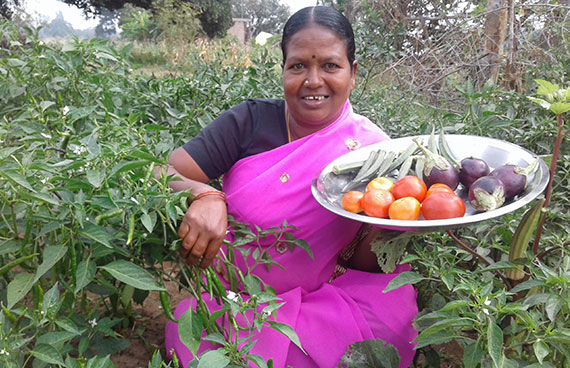The Garden of Good Health
My Story
I live in Velithathankottai village in the Javadhu hills in Tiruvannamalai district of Tamil Nadu. For many years, we had not been managing liquid waste properly and did not know how to grow produce through kitchen gardens.
All this changed when SST came to our village. Mr. Kathirvel first approached us in 2014. SST organized a meeting and formed a SHG (self-help group). I became a member and began taking part in all meetings and activities. We were a total of 30 members, all women.
Slowly, but surely, we began learning and adopting better practices for liquid waste management. We also combined this by creating our own kitchen gardens. As tribals, we included very little vegetables in our diet and so many of us were anaemic. Only 10 percent of us had kitchen gardens.
SST came to the village and Mr. Kathirvel showed us how to get started. Nobody helped us until they stepped in. They gave us seeds for Ladyfinger, Brinjal, Carrot and Papaya amongst others. Slowly, those of us who began growing vegetables in our backyard began to benefit not only from saving money but also improved health. Soon, others began to emulate us.
The vegetables we produce, along with cereals and millets, has made us self-sufficient and left us a surplus to sell to people outside our village. We consume vegetables on all days of the week now and today 60 percent of tribals in the village have kitchen gardens. Each family gets Rs. 300 as additional income.
Awareness about liquid waste management amongst villagers has increased. Villagers now use their kitchen gardens as the easy way to manage liquid waste. SST helped get us organized and we are happy that our quality of life has improved.
The SST Way
Community Development Officer S. Kathirvel who worked with Santhi
When I came to this village in April 2014, 10 percent of tribals had kitchen gardens and they were using waste water. We began by helping them improve their areas by giving new seeds and instructing them in better ways of liquid waste management.
We took this approach as our camps for anaemia check-ups showed 20 percent of the people here in 2014 suffered from lack of iron in their diet. Thanks to the adoption of kitchen gardens by 60 percent of households, the number of those suffering from anaemia has now halved.
It is encouraging to see that awareness about liquid waste management has increased. A lot of training and skills have been imparted to members of the community. What is most heartening is to see that our push to use kitchen gardens as a way to promote liquid waste management has yielded positive results.
We have found that 10 percent of the people are self-motivated. This group will promptly use the seeds we give them, but about 50 percent of people need attention and handholding. Slowly by looking at the healthy lives of their neighbours, they too are feeling emboldened to start their own kitchen gardens.
Santhi as a member of the self-help group was good at motivating others. She would use her garden to show to others what could be achieved. She would help us spread awareness and explain the benefits of having a kitchen garden. Our aim is to ultimately achieve 100 percent adoption of this practice in the village.
Our Takeaways
Villagers and members of the community expect empathy. It is, therefore, important to be regularly in touch with them. There is no point going to them after a long lapse in time.
We have to balance the expectations of all members of the community and manage them.
Patience is a must to build rapport. This takes time but it is essential to gain their trust. Only when they begin to trust us can we succeed.
